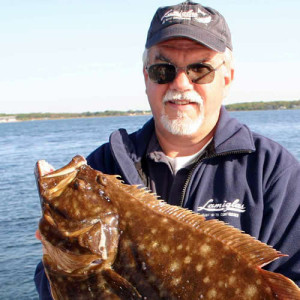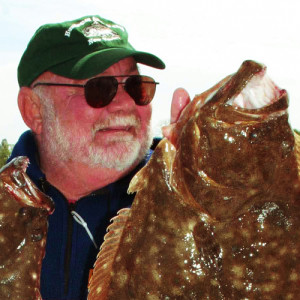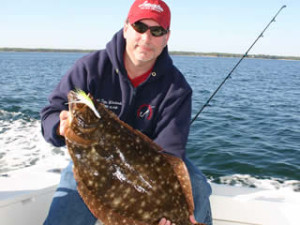Captain Tom Mikoleski
 I’ve fished for fluke from just about every port on Long Island. As a result, it’s safe to say that I know a thing or two about quality fluke fishing. In my opinion, one of the most productive areas to fish for big fluke is off Long Island’s North Fork. This is especially true at the beginning of the season during early May, and on into June. The calm, protected waters that surround Shelter and Gardiner’s Islands are normally full of assorted bait at this time of the season. This large population of bait causes big fluke flock to these waters In order to chow down on the abundant forage.
I’ve fished for fluke from just about every port on Long Island. As a result, it’s safe to say that I know a thing or two about quality fluke fishing. In my opinion, one of the most productive areas to fish for big fluke is off Long Island’s North Fork. This is especially true at the beginning of the season during early May, and on into June. The calm, protected waters that surround Shelter and Gardiner’s Islands are normally full of assorted bait at this time of the season. This large population of bait causes big fluke flock to these waters In order to chow down on the abundant forage.
I love to bucktail jig for big fluke when conditions allow. I strongly feel, the rhythmic action of a jigging bucktail bouncing along the bottom in small hops, is a tough target for a fluke to ignore. Most North Fork fluke fishing takes place in water from 40 to 70-ft deep. Prime time to be bucktail jigging in depths like this is when the drift speed allows a modest 2 to 4-ounce bucktail to easily keep contact with the bottom.
 Bucktail jigs alone will catch fluke, but I find that bucktails are much more productive when a teaser hook is added 6 to 8-inches above the jig. My rigs are created with a 40-pound fluorocarbon leader of about 2-feet in length. To one end of the leader, I tie on a small barrel swivel, and to the other end, I attach a medium sized snap swivel. I then bend the remaining leader in half, and tie in a large sized dropper loop at the approximate mid point. This dropper loop is where the teaser and hook will be attached to the rig.
Bucktail jigs alone will catch fluke, but I find that bucktails are much more productive when a teaser hook is added 6 to 8-inches above the jig. My rigs are created with a 40-pound fluorocarbon leader of about 2-feet in length. To one end of the leader, I tie on a small barrel swivel, and to the other end, I attach a medium sized snap swivel. I then bend the remaining leader in half, and tie in a large sized dropper loop at the approximate mid point. This dropper loop is where the teaser and hook will be attached to the rig.
The reason why I put a snap on this rig is twofold. First, I can easily change bucktail sizes and colors. Secondly, after netting a fluke, the jig and teaser will become all tangled up in the net. It is much easier to get this tangle out by removing the jig from the snap and getting it out of the snarl. When baiting up I prefer to tip the hook on my jig and teaser with combos of a spearing and fresh strips from locally caught squid. Keep your squid strips thin and only about 4-inches in length. When bucktail jigging for fluke it is best not to go crazy long with strips of squid because the strip will often wrap around the hook from the jigging action imparted on the rig. This kills the fluttering action of the strip, and also clogs the hook point. Clogged hook points will cause you to miss some bites.
 There are days when the drift will be too fast for effective bucktail jigging. The fall back option is a simple baited hook on a 3-way rig. I again use 40-pound fluorocarbon leader, this time the leader length is about 3-feet long and has a 5/0 beak style hook tied on to the business end. When baiting up, I again use fresh local squid if I can get it. A thin, pennant shaped strip of squid, about 6 to 8-inches in length is the way to go with a bait rig. Strip baits from fresh caught bluefish or sea robins also make great baits. I always combo my strip baits up with spearing or sand eels.
There are days when the drift will be too fast for effective bucktail jigging. The fall back option is a simple baited hook on a 3-way rig. I again use 40-pound fluorocarbon leader, this time the leader length is about 3-feet long and has a 5/0 beak style hook tied on to the business end. When baiting up, I again use fresh local squid if I can get it. A thin, pennant shaped strip of squid, about 6 to 8-inches in length is the way to go with a bait rig. Strip baits from fresh caught bluefish or sea robins also make great baits. I always combo my strip baits up with spearing or sand eels.
Keep in mind, when drifting for fluke it is crucial that the offering always looks natural. If the bait spins during the drift the catch rate will suffer. Over the years, I have found that in North Fork waters, jigs and teasers tinged in pink often have a definite advantage when fluke fishing. That being said, it’s advisable to also have some white, and chartreuse colored jigs and teasers in the gear bag.
The professional captains and mates who ply these North Fork waters want you to catch fish. So, don’t be afraid to ask for assistance if you are having problems hooking up with fluke. The crews will happily check out your gear and rigging presentations. Often, only a slight change in rigging, baiting, or tackle will go a long ways towards you putting a few jumbo fluke in the cooler by trip end.
